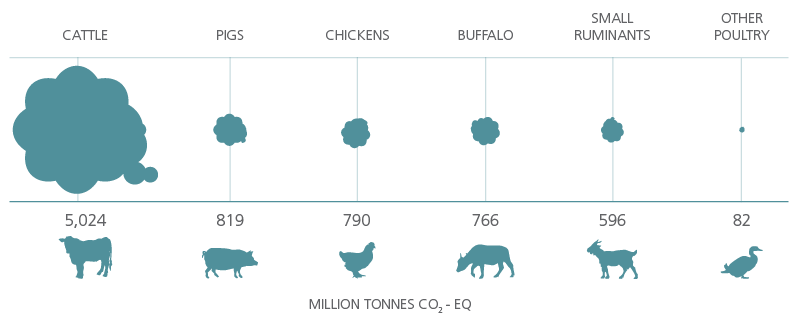The production of livestock has been seen as one of the driving forces for food security and sustainable development of countries. Although, looking at this industry from the perspective of the negative influence on the environment and the subsequent health of the planet is imperative. Livestock production has shown to contribute to climate change, as explored by Grossi, Goglio, Vitali, and Williams (2019) in their research article for Animal Frontiers. The implications of the article were concerned with the need to bring the attention of the public to the issue that the livestock sector requires the use of a large number of natural resources while also adding to the emissions of greenhouse gases. Because of this, it is essential to develop and establish a cohesive mitigation strategy to reduce the intensity of the emissions of such harmful substances as methane and nitrous oxide.
The researchers mention that there is a range of processes within the livestock industry, which contribute to the increase in greenhouse gas emissions. These include changes in land use, the use of pesticides and fertilizers, feed processing, transport, various agricultural operations, as well as manure excreted and applied to fields (Grossi et al., 2019). At livestock farms that do not follow the desired measures of sustainability, the continuous utilization of the land combined with unethical practices of waste disposal results in the increased environmental pollution. Poor animal management and the lack of attention to realizing the full genetic potential of livestock leads to decreased production efficiency.
Grossi et al. (2019) also provide interesting statistics on the production of greenhouses gases by livestock species. Beef and dairy cattle are in the top of the list, with the former producing 1.8 gigatons of carbon dioxide equivalents and the latter producing a gigaton (Grossi et al., 2019). Chicken is at the bottom of the list, producing around 0.1 gigatons. These findings are also supported by the report by the Food and Agriculture Organization of the United Nations (2019) (see Figure 1).

With the recognition of poor practices in the livestock industry, it is necessary to look at mitigation practices that can reduce the adverse impact on the environment. For example, a valuable greenhouse gas reduction strategy can be linked to breeding for more productive animals. This is because a more efficient animal is more likely to retain more nitrogen protein and therefore have lower levels of in urine and feces (Grossi et al., 2019). Also, as pointed out by Williams and Speller (2016), it is necessary to implement the “genetic improvement of daily gain and feed conversion to reduce the emissions per unit of weight” (p. 237). Besides, the creation of new breeds and crosses through genetic technologies will help farmers improve their production systems and increase the efficiency of resources.
In my opinion, the problem of inefficient livestock production should be addressed on a governmental level. Local authorities can monitor sustainability practices and ensure that livestock producers are aware of their impact on the environment. While some of the opponents of livestock production may see it as unethical and inhumane, it is important to understand the ultimate value of meat – it is embedded in our culture and serves as an essential component of global food security. Nevertheless, farms that take care of their animals, keep them clean, happy, and well cared for represent far less danger in terms of environmental pollution.
References
Food and Agriculture Organization of the United Nations. (2019). Gleam 2.0 – Assessment of greenhouse gas emissions and mitigation potential. Web.
Grossi, G., Goglio, P., Vitali, A., & Williams, A. (2019). Livestock and climate change: impact of livestock on climate and mitigation strategies. Animal Frontiers, 9(1), 69-76.
Williams, A., & Speller, D. (2016). Reducing the environmental impact of poultry production. In E.J. Burton, H. M. Gatcliffe, & D. O’Neill (Eds.), Sustainable poultry production in Europe (pp. 235-266). Oxfordshire, UK: CABI.